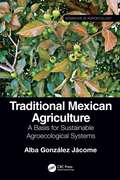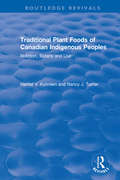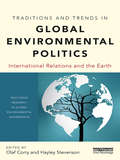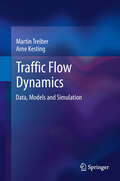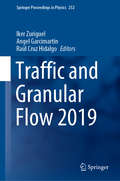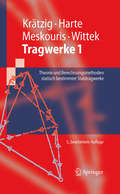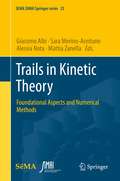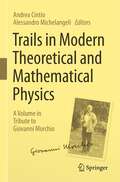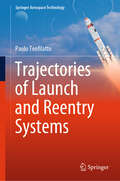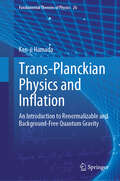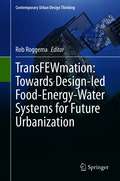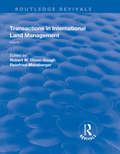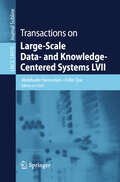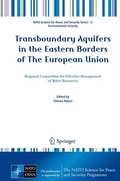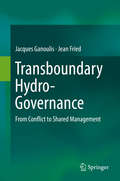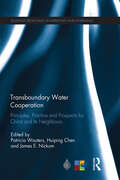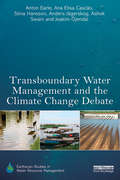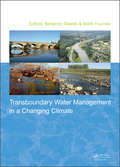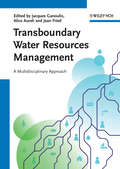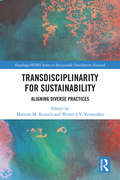- Table View
- List View
Traditional Functional-Discrete Methods for the Problems of Mathematical Physics: New Aspects
by Volodymyr Makarov Nataliya MaykoThis book is devoted to the construction and study of approximate methods for solving mathematical physics problems in canonical domains. It focuses on obtaining weighted a priori estimates of the accuracy of these methods while also considering the influence of boundary and initial conditions. This influence is quantified by means of suitable weight functions that characterize the distance of an inner point to the boundary of the domain. New results are presented on boundary and initial effects for the finite difference method for elliptic and parabolic equations, mesh schemes for equations with fractional derivatives, and the Cayley transform method for abstract differential equations in Hilbert and Banach spaces. Due to their universality and convenient implementation, the algorithms discussed throughout can be used to solve a wide range of actual problems in science and technology. The book is intended for scientists, university teachers, and graduate and postgraduate students who specialize in the field of numerical analysis.
Traditional Mexican Agriculture: A Basis for Sustainable Agroecological Systems (Advances in Agroecology)
by Alba González JácomeThis long-needed book highlights how traditional Mexican agriculture has changed according to environmental, climatic, geographical, social and cultural conditions. Grounded in archaeological-historical data from interrelated research of various scientific disciplines, the book also draws on studies made by anthropologists of varied small-scale agricultural groups. Traditional Mexican Agriculture is the result of a holistic study of Mexican agriculture. It offers the reader a perspective of traditional agriculture in Mexico from social, cultural and ecological Anthropology, Ethnology, regional and environmental History, and Agroecology, to help obtain sustainable agroecology where human societies obtain better ways of life and a healthy and nutritious food system. The book further aims to recover ideas, management, and components of local knowledge of small-scale farmers. Pitched at university students and academics, as well as researchers and developers of agricultural matters, this book will be ideal reading at agrarian universities and related institutions. It provides a basis for future studies in sustainable agricultural systems in this region.
Traditional Plant Foods of Canadian Indigenous Peoples: Nutrition, Botany and Use (Routledge Revivals)
by Harriet Kuhnlein Nancy J TurnerFirst published in 1991, Traditional Plant Foods of Canadian Indigenous Peoples details the nutritional properties, botanical characteristics and ethnic uses of a wide variety of traditional plant foods used by the Indigenous Peoples of Canada. Comprehensive and detailed, this volume explores both the technical use of plants and their cultural connections. It will be of interest to scholars from a variety of backgrounds, including Indigenous Peoples with their specific cultural worldviews; nutritionists and other health professionals who work with Indigenous Peoples and other rural people; other biologists, ethnologists, and organizations that address understanding of the resources of the natural world; and academic audiences from a variety of disciplines.
Traditional Rainwater Harvesting Structures (SpringerBriefs in Water Science and Technology)
by Joji V.S. Reshma Susan JacobThis book contains detailed information about the traditional rainwater structures. Harvesting rainwater is becoming as a practical adaptation strategy for urban areas that are vulnerable to climate alteration. In the past, rainwater harvesting was more significant than it is today. Studies show that a variety of traditional and age-old rainwater gathering techniques were created or put into use in reaction to earlier climate change incidents. According to history, both floods and droughts were frequent occurrences in ancient India. Perhaps this explains why each region of the nation has its own traditional water gathering practices that are representative of the local physical and cultural diversity. All of these methods can be seen as a concept of harvesting rain whenever and wherever it falls. Water makes up 70.9 % of the Earth's surface, mainly in the form of oceans and seas. Water is found in modest proportions as 1.7 % groundwater, 1.7 % glaciers and ice caps in Antarctica and Greenland, vapour, clouds (ice and liquid water suspended in air), and 0.001% precipitation in the air. Evaporation, transpiration, evapo-transpiration, condensation, precipitation, root absorption, percolation, infiltration, base flow and runoff are processes that water goes through on its way to the sea.
Traditions and Trends in Global Environmental Politics: International Relations and the Earth (Routledge Research in Global Environmental Governance)
by Hayley Stevenson Olaf CorryHow can a divided world share a single planet? As the environment rises ever higher on the global agenda, the discipline of International Relations (IR) is engaging in more varied and transformative ways than ever before to overcome environmental challenges. Focusing in particular on the key trends of the past 20 years, this volume explores the main developments in the global environmental crisis, with each chapter considering an environmental issue and an approach within IR. In the process, adjacent fields including energy politics, science and technology, and political economy are also touched on. Traditions and Trends in Global Environmental Politics is aimed at anybody interested in the key international environmental problems of the day, and those seeking clarification and inspiration in terms of approaches and theories that decode how the environment is accounted for in global politics. It will be an essential resource for students and scholars of global environmental politics and governance, environmental studies and IR.
Traffic Flow Dynamics: Data, Models and Simulation
by Martin Treiber Arne Kesting Christian ThiemannThis textbook provides a comprehensive and instructive coverage of vehicular traffic flow dynamics and modeling. It makes this fascinating interdisciplinary topic, which to date was only documented in parts by specialized monographs, accessible to a broad readership. Numerous figures and problems with solutions help the reader to quickly understand and practice the presented concepts. This book is targeted at students of physics and traffic engineering and, more generally, also at students and professionals in computer science, mathematics, and interdisciplinary topics. It also offers material for project work in programming and simulation at college and university level. The main part, after presenting different categories of traffic data, is devoted to a mathematical description of the dynamics of traffic flow, covering macroscopic models which describe traffic in terms of density, as well as microscopic many-particle models in which each particle corresponds to a vehicle and its driver. Focus chapters on traffic instabilities and model calibration/validation present these topics in a novel and systematic way. Finally, the theoretical framework is shown at work in selected applications such as traffic-state and travel-time estimation, intelligent transportation systems, traffic operations management, and a detailed physics-based model for fuel consumption and emissions.
Traffic and Granular Flow 2019 (Springer Proceedings in Physics #252)
by Iker Zuriguel Angel Garcimartín Raúl Cruz HidalgoThis book gathers contributions on a variety of flowing collective systems. While primarily focusing on pedestrian dynamics, they also reflect the latest developments in areas such as vehicular traffic and granular flows and address related emerging topics such as self-propelled particles, data transport, swarm behavior, intercellular transport, and collective dynamics of biological systems. Combining fundamental research and practical applications in the various fields discussed, the book offers a valuable asset for researchers and practitioners alike.
Tragwerke 1
by Konstantin Meskouris Reinhard Harte Udo Wittek Wilfried B. KrätzigDas Standardlehrwerk beschäftigt sich mit der Ermittlung der Kraft- und Verformungszustände von allgemeinen, statisch bestimmten Stabtragwerken sowie von wichtigen Tragwerkstypen. Dabei vereint es die Grundlagen der technischen Mechanik mit der konzeptionellen, tragwerksspezifischen Problemlösung. Dargestellt werden die fundamentalen Abstraktions- und Arbeitsmethoden, die wesentlichen analytischen Berechnungsmethoden werden an typischen Beispielen erläutert. Die Neuauflage berücksichtigt aktuelle Normen und neue Bezeichnungen.
Tragwerke 1: Theorie und Berechnungsmethoden statisch bestimmter Stabtragwerke (Springer-Lehrbuch)
by Konstantin Meskouris Reinhard Harte Udo Wittek Wilfried B. KrätzigDas Standardlehrwerk beschäftigt sich mit der Ermittlung der Kraft- und Verformungszustände von allgemeinen, statisch bestimmten Stabtragwerken sowie von wichtigen Tragwerkstypen. Dabei vereint es die Grundlagen der technischen Mechanik mit der konzeptionellen, tragwerksspezifischen Problemlösung. Dargestellt werden die fundamentalen Abstraktions- und Arbeitsmethoden, die wesentlichen analytischen Berechnungsmethoden werden an typischen Beispielen erläutert. Die Neuauflage berücksichtigt aktuelle Normen und neue Bezeichnungen.
Trails in Kinetic Theory: Foundational Aspects and Numerical Methods (SEMA SIMAI Springer Series #25)
by Giacomo Albi Sara Merino-Aceituno Alessia Nota Mattia ZanellaIn recent decades, kinetic theory - originally developed as a field of mathematical physics - has emerged as one of the most prominent fields of modern mathematics. In recent years, there has been an explosion of applications of kinetic theory to other areas of research, such as biology and social sciences. This book collects lecture notes and recent advances in the field of kinetic theory of lecturers and speakers of the School “Trails in Kinetic Theory: Foundational Aspects and Numerical Methods”, hosted at Hausdorff Institute for Mathematics (HIM) of Bonn, Germany, 2019, during the Junior Trimester Program “Kinetic Theory”. Focusing on fundamental questions in both theoretical and numerical aspects, it also presents a broad view of related problems in socioeconomic sciences, pedestrian dynamics and traffic flow management.
Trails in Modern Theoretical and Mathematical Physics: A Volume in Tribute to Giovanni Morchio
by Alessandro Michelangeli Andrea CintioThis book celebrates the life and work of the late Giovanni Morchio (1944–2021). It features scientific and anecdotal contributions written by his former colleagues, co-authors, and students, as well as senior scientists who were active witnesses to the dramatic advances in physics and in mathematics that took place during his 50-year-long career. The volume begins with a biographical introduction, detailing Giovanni Morchio’s life and his role as a physicist, mathematician, teacher, and scientist. The core of the book covers a vast spectrum of ideas, reflecting Dr Morchio’s scientific interests. Each chapter develops a specific topic of modern research, ranging from quantum mechanics and quantum field theory to additional themes such as the connection between general relativity and Newtonian gravitation. Every contribution provides a historical retrospective, a survey of advances, an outlook of future perspectives and challenges, and an updated bibliography. The last part collects the authors’ recollections of their professional and personal interactions with Dr Morchio, in recognition of his deep achievements, his exceptional pedagogical qualities, and his praiseworthy social and pro bono commitment. Authored by physicists of international calibre covering a broad range of subjects, the book will be a valuable reference for researchers and students of theoretical and mathematical physics.
Trajectories in Oceanography (Springer Oceanography)
by Emil StanevThis book presents the development of oceanography of European regional and coastal seas over the last 50 years. It describes the evolution of scientific practice alongside the technological development of measurements and computer modelling. Emphasis is placed on transformation of basic research into applied science and services. This reflects the growing public awareness of ocean issues. The recent advancements in the field of operational oceanography are presented as an important scientific response to the needs of environmental protection and sustainable development. The book could be of interest to scientists and students in various fields of oceanography, to practitioners in the field, and to the general readership interested in environmental sciences.
Trajectories of Launch and Reentry Systems (Springer Aerospace Technology)
by Paolo TeofilattoThis book examines ascent trajectories of space launch vehicles and re-entry trajectories of space capsules. The decommissioned SCOUT is used as a reference launcher and the reader will be introduced to various and detailed aspects of a launch vehicle that are not generally available in the literature, since this information is limited to internal industry and agency reports. The SCOUT data are used here as a study case and the reader will be able to generate a complete numerical code using the general equations of flight introduced in different reference systems, including the time-dependent parameters representing the launcher and its environment with a high degree of accuracy. The guidance parameters for injection into orbits of different semiaxes, eccentricities and inclinations are determined by guessed values obtained by original analytical formulae. These formulae allow a fast and sufficiently accurate design of the rocket trajectory within the atmosphere; in the exo-atmospheric flight closed form solutions of the optimal problem of injection into orbit are provided. The second part of the book deals with re-entry trajectories. Basic analytical formulae for ballistic reentry are presented to evaluate the reentry trajectory and the capsule design in terms of critical parameters such as temperature and load peak. Entry corridors for ballistic reentry trajectories are then determined for various planets with atmospheres. The effect of lift is analysed to increase the entry corridors and guide the capsule to a target landing point. Autonomous and real-time guidance algorithms are developed for capsule of low aerodynamic efficiency and winged re-entry vehicles.
Trans-Planckian Physics and Inflation: An Introduction to Renormalizable and Background-Free Quantum Gravity (Fundamental Theories of Physics #26)
by Ken-ji HamadaThis book comprehensively describes recent developments in the research of renormalizable quantum gravity, focusing on its application to physics beyond the Planck scale, particularly in inflationary cosmology. It challenges the notion that the Planck scale is an impassable barrier, addressing issues such as singularity, renormalizability, unitarity, time, primordial fluctuations, and the cosmological constant. To describe the trans-Planckian world, it is necessary to break away from the view of graviton scattering and carry out the quantization of spacetime itself. Utilizing conformal field theory techniques to achieve background freedom, the book presents a renormalizable quantum theory of gravity that overcomes the Planck-scale wall. Historically, discussions on renormalizability of gravity declined due to ghost issues. However, ghosts are essential in gravitational systems where the total Hamiltonian/momentum vanishes strictly, for aspects such as cosmic entropy, the formation of the universe, and gravitational objects. Quantum gravity approaches known in recent years often break diffeomorphism invariance or sacrifice renormalizability to eliminate ghosts. In contrast, this book presents a novel attempt which maintains that these are guiding principles even in the trans-Planckian domain, but constrains ghosts to be unphysical. The renormalizability implies a new scale that leads to a quantum gravity inflation scenario with a spacetime phase transition as the Big Bang. This book offers fresh insights into the trans-Planckian physics for graduate students and researchers.
TransFEWmation: Towards Design-led Food-Energy-Water Systems for Future Urbanization (Contemporary Urban Design Thinking)
by Rob RoggemaThis book discusses a spectrum of approaches to designing the food-energy-water nexus at different spatial-urban scales. The book offers a framework for working on the FEW-nexus in a design-led context and integrates the design of urban neighbourhoods and regions with methodologies how to simultaneously engaging residents and stakeholders and evaluating the propositions in a FEW-print, measuring the environmental impact of the different designs. The examples are derived from on the ground practices in Sydney, Tokyo, Detroit, Amsterdam and Belfast.
Transactions in International Land Management: Volume 1 (International Land Management Ser. #Vol. 2)
by Robert W. Dixon-Gough Reinfried MansbergerTransactions in International Land Management is a new series of volumes which provides an arena for the debate of key topical issues on this subject. In this first volume, the subjects divide into three broad sections. Firstly, there are analyses of land reform and agrarian structure in Europe, including case studies from Macedonia and Estonia and a comparative examination of land registration and agrarian reform in Austria and Great Britain. Secondly, there are chapters looking at various methodologies and tools used in developing and appraising land management, including Geo-information systems. Finally, there are a couple of chapters which study urban growth in Africa: one examining a mining town in Zambia and the other focussing on housing in Zanzibar to discuss issues of informal land delivery and management.
Transactions on Large-Scale Data- and Knowledge-Centered Systems LVII (Lecture Notes in Computer Science #14970)
by Abdelkader Hameurlain A Min TjoaThe LNCS journal Transactions on Large-scale Data and Knowledge-centered Systemsfocuses on data management, knowledge discovery, and knowledge processing, which arecore and hot topics in computer science. Since the 1990s, the Internet has become the maindriving force behind application development in all domains. An increase in the demand forresource sharing (e.g. computing resources, services, metadata, data sources) across differentsites connected through networks has led to an evolution of data- and knowledge-managementsystems from centralized systems to decentralized systems enabling large-scale distributedapplications providing high scalability. This, the 57th issue of Transactions on Large-scale Data and Knowledge-centered Systems,contains five fully revised selected regular papers. Topics covered include leveraging machinelearning for effective data management, access control models, reciprocal authorizations,Internet of Things, digital forensics, code similarity search, volunteered geographicinformation, and spatial data quality.
Transboundary Aquifers in the Eastern Borders of The European Union
by Tomasz NałęczThis book focuses on sustainable use and protection of transboundary aquifers located along the eastern border of European Union starting from the Baltic Sea and end in the Black Sea. The groundwater resources in this region play a very important role not only as a source of clean and safe drinking water, but also for social, economic and safety reasons. This publication sheds light on a wide range of real problems related to the management of groundwater, problems that are characteristic for most countries situated in the East European region. It also identifies potential threats that may materialise in the absence of cooperation between countries and appropriate measures to jointly manage the shared water resources in the region. Experience from some ongoing projects towards integrated management of transboundary aquifers (research, monitoring and data analysis) is reported. The book is addressed, in particular, to groundwater academics, researchers and experts as well as water management specialists interested in solving environmental issues extended to more than one country territory. On the other hand presented knowledge and experience would be also useful for decision makers especially to support environmental decision processes in border areas and work on preparation of international agreements on groundwater management.
Transboundary Aquifers in the Eastern Borders of The European Union: Regional Cooperation for Effective Management of Water Resources (NATO Science for Peace and Security Series C: Environmental Security)
by Tomasz NałęczThis book focuses on sustainable use and protection of transboundary aquifers located along the eastern border of European Union starting from the Baltic Sea and end in the Black Sea. The groundwater resources in this region play a very important role not only as a source of clean and safe drinking water, but also for social, economic and safety reasons. This publication sheds light on a wide range of real problems related to the management of groundwater, problems that are characteristic for most countries situated in the East European region. It also identifies potential threats that may materialise in the absence of cooperation between countries and appropriate measures to jointly manage the shared water resources in the region. Experience from some ongoing projects towards integrated management of transboundary aquifers (research, monitoring and data analysis) is reported. The book is addressed, in particular, to groundwater academics, researchers and experts as well as water management specialists interested in solving environmental issues extended to more than one country territory. On the other hand presented knowledge and experience would be also useful for decision makers especially to support environmental decision processes in border areas and work on preparation of international agreements on groundwater management.
Transboundary Hydro-Governance: From Conflict to Shared Management
by Jacques Ganoulis Jean FriedAttending water security is an important challenge and a major systemic risk humanity faces in the years to come. This is due to population increase, over-consumption of water, especially in agriculture, climate change and various forms of water pollution. The issue becomes more complicated in transboundary water catchments that cover almost half of the world’s land surface, with about 60% of global river flow and 40% of the world’s population. Also, in many parts of the planet, like Saharan Africa, population depends on groundwater resources located in transboundary aquifer systems. These facts illustrate the importance of the book's subject, which is the governance of transboundary waters, both surface and groundwater.The book is written by two distinguished scientists, who, having worked in various international institutions, like UNESCO, GEF, UNEP and at the European Commission, have both an extended expertise on how to bridge the gap between science and political decision-making, which is the main factor for an effective governance of water resources. What is new in the book is the integrated analysis of transboundary governance of both surface water and groundwater, as it occurs in reality. In current literature, groundwater is still often missing for the benefit of surface water or, on the contrary, it is treated separately from surface water. The most important feature of the book is to distinguish between the real and a "good" or an effective transboundary water governance and to provide practical tools, methodologies and examples for its implementation in the field. Published timely during 2018, the book will contribute to address successfully practical problems of governance of transboundary waters that represent a very important part of our precious fresh water resources.
Transboundary Water Cooperation: Principles, Practice and Prospects for China and Its Neighbours (Routledge Special Issues on Water Policy and Governance)
by James E. Nickum Patricia Wouters Huiping ChenChina and its neighbours face a series of water security issues, in which international law plays a vital role. Paramount to both policymakers and researchers in the field of water law, the current status of transboundary water cooperation schemes and how these operate in China is of global significance. Grounded in international experience, this comprehensive volume provides readers with an up-to-date overview of current international transboundary water resource sharing policies and practices, including detailed case studies at both domestic and international levels. The authors discuss existing international laws, treaties, and principles that may stimulate transboundary water cooperation and dialogue, and then analyse a number of international experiences with treaties in North America, Eastern Europe, and Central Asia. They take stock of China’s water resource issues, legal practices and options, examine case studies of China’s southern shared rivers, and explore some innovative approaches to cooperative management of shared waters within China. The articles in this book were originally published in the journal Water International.
Transboundary Water Management and the Climate Change Debate (Earthscan Studies in Water Resource Management)
by Joakim Öjendal Stina Hansson Ashok Swain Anders Jägerskog Anton Earle Ana CascaoClimate change has an impact on the ability of transboundary water management institutions to deliver on their respective mandates. The starting point for this book is that actors within transboundary water management institutions develop responses to the climate change debate, as distinct from the physical phenomenon of climate change. Actors respond to this debate broadly in three distinct ways – adapt, resist (as in avoiding the issue) and subvert (as in using the debate to fulfil their own agenda). The book charts approaches which have been taken over the past two decades to promote more effective water management institutions, covering issues of conflict, cooperation, power and law. A new framework for a better understanding of the interaction between transboundary water management institutional resilience and global change is developed through analysis of the way these institutions respond to the climate change debate. This framework is applied to six river case studies from Africa, Asia and the Middle East (Ganges-Brahmaputra, Jordan, Mekong, Niger, Nile, Orange-Senqu) from which learning conclusions and policy recommendations are developed.
Transboundary Water Management in a Changing Climate
by Benjamin Dewals Maïté FournierMost large river basins in the world are transboundary. Experience with such basins emphasizes the urgent need for more efficient transnational water management. This book details recent initiatives undertaken in the Meuse basin (North-West Europe) to develop a transnational adaptation strategy to deal with the impact of climate change.In the 21st
Transboundary Water Resources Management: A Multidisciplinary Approach (Nato Science Partnership Subseries: 2 Ser. #7)
by Jacques Ganoulis Jean Fried Alice AureliBased on an international symposium addressing a key issue in global development, this reference includes both the latest methodologies for and practical examples of effective management of transboundary water resources. Its multidisciplinary approach combines hydrology and environmental science with economic and political approaches, in line with new UNESCO and EU recommendations, which have been formulated and implemented with the active involvement of all three editors. By providing a theoretical framework as well as abundant case studies from southern Europe, Africa, Asia and South America, this handbook provides hydrologists, geologists, engineers and decision-makers with all the knowledge they need for their daily work.
Transdisciplinarity For Sustainability: Aligning Diverse Practices (Routledge/ISDRS Series in Sustainable Development Research)
by Martina M. Keitsch; Walter J.V. VermeulenThis volume explores interactions between academia and different societal stakeholders with a focus on sustainability. It examines the significance and potential of transdisciplinary collaboration as a tool for sustainability and the SDGs. Traditionally, academia has focused on research and education. More recently, however, the challenges of sustainable development and achieving the SDGs have required the co-production of knowledge between academic and non-academic actors. Compromising theory, methods and case studies from a broad span of transdisciplinary collaboration, Transdisciplinarity For Sustainability: Aligning Diverse Practices is written by specialists from various academic disciplines and represents an important step forward in systematising knowledge and understanding of transdisciplinary collaboration. They are designed to provide a roadmap for further research in the field and facilitate pursuing and realizing the SDGs. The book will appeal to researchers and postgraduate students in a variety of disciplines such as architecture, design, economics, social sciences, engineering and sustainability studies. It will also be of significant value to professionals who are engaged in transdisciplinary collaboration that supports sustainable development.

